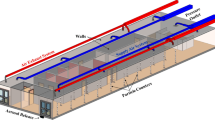Abstract
Ventilation is a main method to control the contaminant dispersion within clean wards. In this paper, we investigated the effects of various ventilation designs of the bathroom in an ISO Class 5 clean ward. Specifically, the contaminant dispersion and particle concentrations corresponding to three different ventilation design schemes were characterized and compared using computational fluid dynamics (CFD) analysis. For each design, we examined airflow and particle concentrations for contaminant sources located at two places (i.e., at the toilet seat and on the floor), respectively. Field test was conducted to compare the measured and simulated air velocities and particle concentrations in a hospital clean ward. The implemented CFD modeling of ventilation effects of various designs in this study has proven to accurately characterize airflow and contaminant control in the ventilated space, and has led to optimizing ventilation for the bathroom in an ISO Class 5 clean ward.
Similar content being viewed by others
References
Bloch AB, Orenstein WA, Ewing WM, Spain WH, Mallison GF, Herrmann KL, Hinman AR (1985). Measles outbreak in a pediatric practice: Airborne transmission in an office setting. Pediatrics, 75(4): 676–683.
CDC (2003). Guidelines for Environmental Infection Control in Health-Care Facilities. Atlanta, GA: US Department of Health and Human Services, Public Health Service, Centers for Disease Control and Prevention.
Chen F, Yu SCM, Lai ACK (2006). Modeling particle distribution and deposition in indoor environments with a new drift-flux model. Atmospheric Environment, 40: 357–367.
Chen Q (1995). Comparison of different k-ε models for indoor air flow computations. Numerical Heat Transfer, 28 (B): 353–369.
FLUENT Version 6.2 (2005). Fluent Inc., Lebanon, New Hampshire, USA.
GB50073-2001 (2001). Clean Room Design Criterion. Beijing: China Plans Press. (in Chinese)
Gustafson TL, Lavely GB, Brawner ER, Hutcheson RH, Wright PF, Schaffner W (1982). An outbreak of airborne nosocomial varicella. Pediatrics, 70 (4): 550–556.
IEST-RP-CC012.2 (2007). Considerations in Cleanroom Design. The Institute of Environmental Sciences and Technology (IEST), IL, USA.
International Organization for Standardization (ISO) (1999). ISO 14644-1, Cleanrooms and Associate Controlled Environments-Part 1-Classification of Air Cleanliness. The Institute of Environmental Sciences and Technology (IEST). IL, USA.
Pizzo PA (1981). The value of protective isolation in preventing nosocomial infections in high risk patients. American Journal of Medicine, 70: 631–637.
Riley RL, Mills CC, Grady FO, Sultan LU, Wittstadt F, Shivpuri DN (1962). Infectiousness of air from a tuberculosis ward. The American Review of Respiratory Disease, 85: 511–525.
Rouaud O, Havet M (2002). Computation of the airflow in a pilot scale clean room using k-ε turbulence models. International Journal of Refrigeration, 25 (3): 351–361.
Tu G (2006). Cleanroom and Air Conditioning of Pharmaceutical Factual. Beijing: China Architecture & Building Press. (in Chinese)
Yokhot V, Orzag SA, Thangam S, Gatski TB, Speziale CG (1992). Development of turbulence models for shear flows by a double expansion technique. Physics of Fluids A, 4 (7): 1510–1520.
Author information
Authors and Affiliations
Corresponding author
Rights and permissions
About this article
Cite this article
Yang, C., Yang, X., Xu, T. et al. Optimization of bathroom ventilation design for an ISO Class 5 clean ward. Build. Simul. 2, 133–142 (2009). https://doi.org/10.1007/s12273-009-9310-1
Received:
Revised:
Accepted:
Published:
Issue Date:
DOI: https://doi.org/10.1007/s12273-009-9310-1




